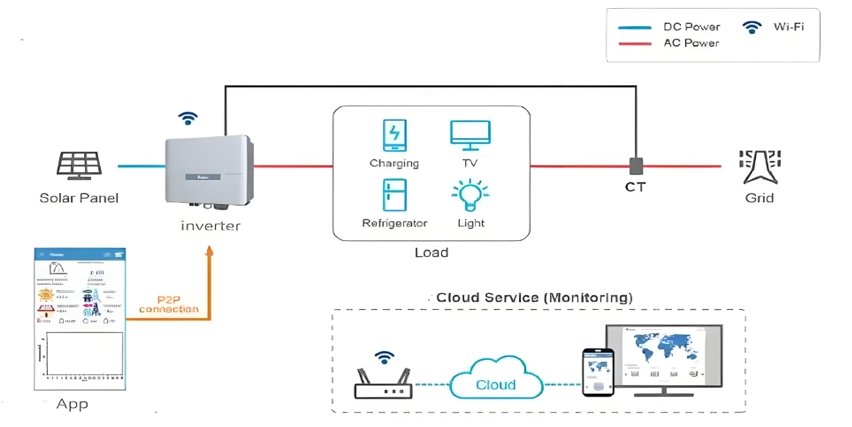
Rooftop solar panels on house
Reverse flow protection is a critical feature of photovoltaic (PV) inverters that ensures solar energy flows in the correct direction—away from the inverter to the home or grid, but never the other way around. This feature is particularly important in grid-tied systems, where excess energy generated by solar panels can flow back into the grid. Reverse flow protection prevents the reverse flow of power, which is essential for the safe and efficient operation of solar systems. In this article, we’ll explore how reverse flow protection works, why it is important, and how it is regulated.
Reverse flow protection is vital for the operation of grid-connected solar systems. Let’s dive deeper into its mechanisms and importance.
How Does Reverse Flow Protection Prevent Energy from Flowing Back Into the Grid?
Reverse flow protection ensures that energy generated by the solar panels only flows to the household or to the grid, but never flows back into the grid from the inverter. This is achieved through intelligent inverter control and protective mechanisms that monitor power direction.
Let’s look at how reverse flow protection stops energy from reversing direction and causing potential issues.
Mechanisms of Reverse Flow Protection
-
Grid Disconnect Feature:
- Inverters are designed to disconnect from the grid if reverse power flow is detected. This can happen if the grid experiences a power outage or if the solar power generation exceeds the consumption at the household level, pushing excess energy back into the grid. Learn more about grid disconnect features here1.
-
Power Flow Control:
- The inverter monitors power flow in real time, ensuring that any excess energy generated is either consumed by the home or fed into the grid. If reverse flow is detected (i.e., energy starts flowing back into the grid), the inverter automatically adjusts its operation to prevent this. Learn more about power flow control here2.
-
Anti-Islanding Protection:
Conclusion: Reverse flow protection works by ensuring that excess energy is either used by the household or directed into the grid without causing power to flow back into the grid, where it can cause problems. This feature is critical for both safety and grid stability.
Why Is Reverse Flow Protection Important for Grid-Tied Solar Systems?
For grid-tied solar systems, reverse flow protection plays an important role in both safety and efficiency. It prevents excess energy from harming the grid infrastructure or violating regulations. Without reverse flow protection, the grid could face complications, especially if excess solar power is fed back into it at inappropriate times.
Let’s explore why reverse flow protection is essential for grid-tied solar systems.

Solar power system diagram
Importance of Reverse Flow Protection
-
Grid Stability:
-
Safety Concerns:
- Without reverse flow protection, there is a risk of backfeeding during grid outages. This can create dangerous conditions for utility workers trying to restore power. Reverse flow protection ensures that the inverter stops feeding energy into the grid during such situations, ensuring the safety of everyone involved. Learn more about safety and backfeeding here5.
-
Compliance with Regulations:
- Many countries and regions have regulations that prevent energy from flowing back into the grid unless specific conditions are met (e.g., net metering arrangements). Reverse flow protection ensures compliance with these regulations, preventing the inverter from sending power to the grid when it’s not allowed. Learn more about regulations for grid-tied systems here6.
Conclusion: Reverse flow protection is critical for maintaining grid stability, safety, and regulatory compliance in grid-tied solar systems. Without it, there could be risks of damaging the grid infrastructure and creating unsafe conditions.
How Do Inverters Detect and Manage Reverse Power Flow?
Inverters are designed with sophisticated monitoring systems that detect the direction of power flow and manage it accordingly. These systems prevent reverse power flow by constantly monitoring energy production and consumption.
Let’s dive into the technology behind how inverters detect and manage reverse power flow.

Growatt inverter installation
Inverter Detection and Management of Reverse Power Flow
-
Real-Time Power Monitoring:
- Inverters use advanced sensors and software to monitor the amount of power being generated by the solar panels and consumed by the home. If excess energy is being generated and not consumed, the inverter directs it to the grid. If power flow starts reversing, the inverter detects this and immediately disconnects the grid connection. Learn more about real-time power monitoring in solar systems here7.
-
Voltage and Frequency Monitoring:
- Inverters measure the voltage and frequency of both the grid and the output from the solar panels. If the inverter detects that the solar energy is flowing back into the grid (reverse power), it can isolate itself from the grid or adjust power output to ensure it doesn’t feed power back into the grid. Learn more about voltage and frequency monitoring here8.
-
Anti-Islanding Detection:
- Anti-islanding is a critical safety feature. If there’s a grid failure, the inverter quickly detects this by monitoring grid voltage and frequency. If the grid goes down, the inverter will shut off its connection to the grid, preventing reverse flow of energy to a dead grid. Learn more about anti-islanding protection here9.
Conclusion: Inverters use real-time power monitoring, voltage and frequency analysis, and anti-islanding detection to ensure that energy only flows in the correct direction, protecting both the household and the grid from reverse power flow.
What Are the Regulatory Requirements for Reverse Flow Protection in Solar Inverters?
Regulatory requirements for reverse flow protection vary by country, but most regions require solar inverters to have some form of protection to prevent reverse energy flow. These regulations ensure that inverters operate safely and in compliance with local grid codes.
Let’s review the regulatory standards and requirements for reverse flow protection in solar inverters.

Growatt hybrid solar system diagram
Regulatory Requirements for Reverse Flow Protection
-
Grid Codes and Standards:
- Different countries have specific grid codes that require reverse flow protection in all grid-tied solar systems. For example, in Europe, the IEC 62116 standard mandates that inverters must have anti-islanding protection, while the IEEE 1547 standard in the U.S. outlines requirements for reverse power flow prevention. To learn more about IEC 62116, click here10.
-
Net Metering and Feed-in Tariffs:
- In regions with net metering or feed-in tariff programs, reverse flow protection is required to ensure that excess solar energy is only fed into the grid under the correct conditions (e.g., when allowed by the utility company). Inverters must prevent power from flowing back into the grid unless there is a proper agreement in place. Learn more about net metering and feed-in tariffs here11.
-
Safety and Compliance:
- Regulatory bodies require that inverters comply with safety standards to protect both the grid and the public. Reverse flow protection ensures that energy does not flow into the grid during outages, preventing harm to utility workers and maintaining system stability. More information on safety compliance can be found here12.
Conclusion: Reverse flow protection is a regulatory requirement in many regions, designed to ensure that solar inverters operate safely and in compliance with grid codes. These requirements help maintain grid stability and protect against safety hazards.
Conclusion
Reverse flow protection is a crucial feature for grid-tied solar inverters. It ensures that energy generated by solar panels is safely directed to the home or the grid, preventing reverse power flow that could destabilize the grid or create safety risks. Inverters use sophisticated monitoring and protection systems to detect and manage reverse power flow, and regulatory requirements ensure that these systems meet safety standards.
For a safe, efficient, and compliant solar energy system, reverse flow protection is essential, ensuring both regulatory compliance and the safety of everyone involved in the grid’s operation.
-
Learn more about grid disconnect features
Explore how inverters disconnect from the grid in case of reverse power flow. ↩ -
Learn more about power flow control
Understand how inverters manage power flow to prevent reverse energy transfer. ↩ -
Learn more about anti-islanding protection
Find out how anti-islanding protection ensures safety during grid outages. ↩ -
Learn more about grid stability and reverse flow protection
Understand how reverse flow protection contributes to overall grid stability. ↩ -
Learn more about safety and backfeeding
Find out how reverse flow protection helps ensure safety during grid outages. ↩ -
Learn more about regulations for grid-tied systems
Explore the regulations that prevent backfeeding in grid-tied solar systems. ↩ -
Learn more about real-time power monitoring in solar systems
Explore how inverters use real-time power monitoring to prevent reverse power flow. ↩ -
Learn more about voltage and frequency monitoring
Understand how voltage and frequency monitoring ensure proper energy flow. ↩ -
Learn more about anti-islanding protection
Find out how anti-islanding protection ensures safety during grid failures. ↩ -
Learn more about IEC 62116 standard
Find out how the IEC 62116 standard mandates reverse flow protection and anti-islanding features. ↩ -
Learn more about net metering and feed-in tariffs
Explore how reverse flow protection is tied to net metering and feed-in tariff systems. ↩ -
Learn more about safety compliance
Understand how inverters ensure safety during power outages and grid-related issues. ↩



